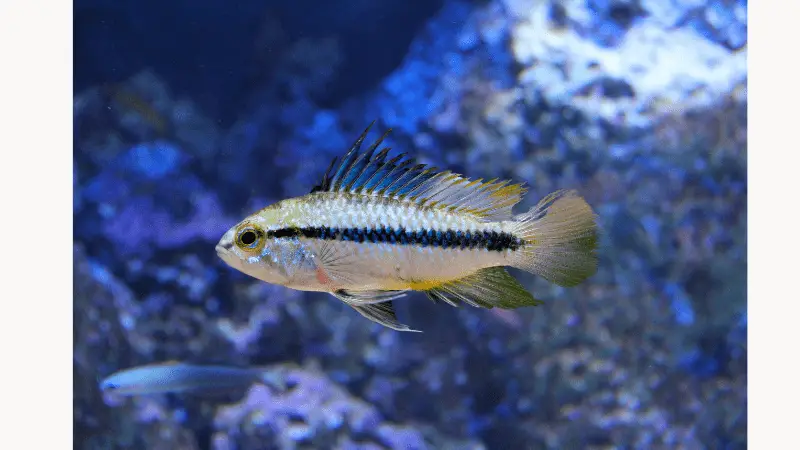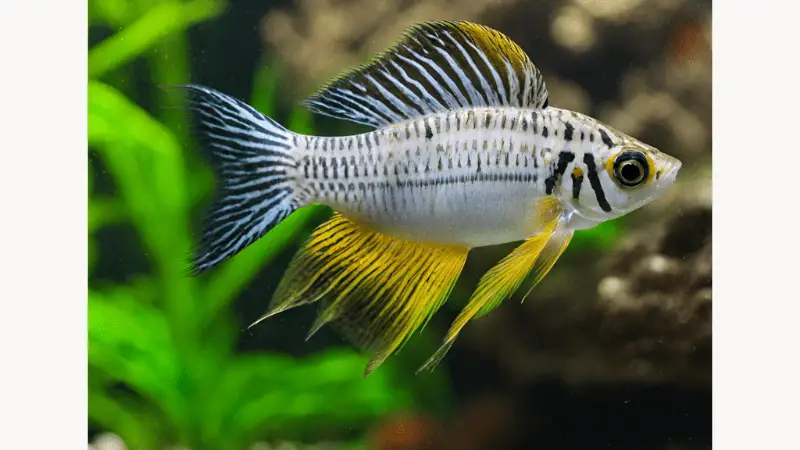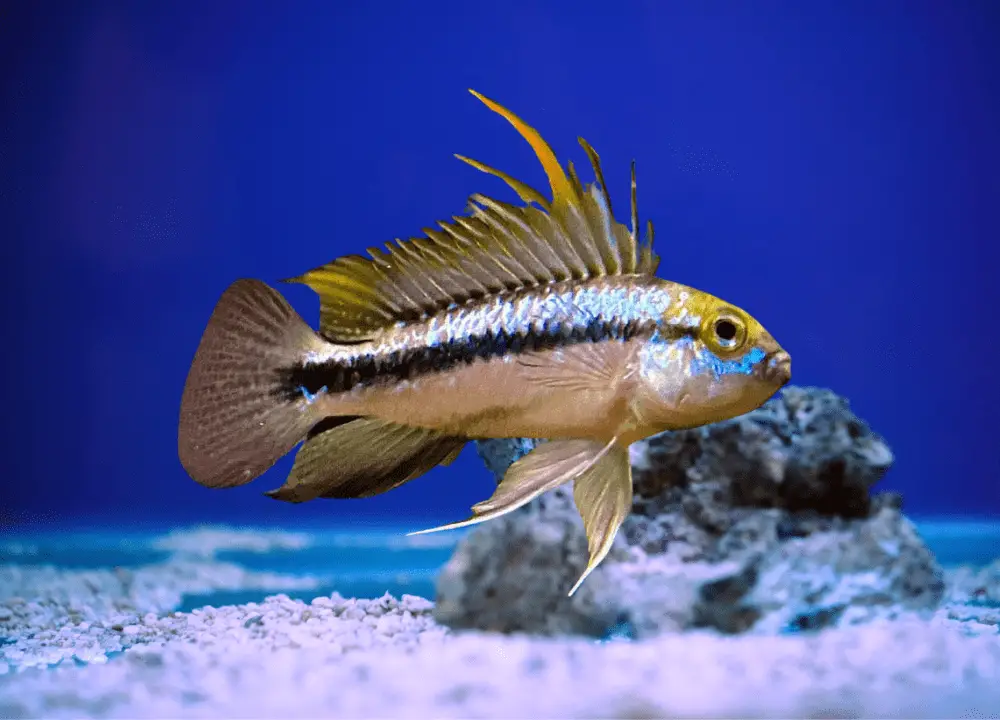Apistogramma trifasciata, also known as the Three-striped Apisto, is a captivating dwarf cichlid originating from South America. Its vibrant colors and manageable size make it a popular choice among aquarium enthusiasts.
The Three-striped Apisto is treasured for its dazzling appearance and dynamic personality, offering a splash of vitality to any freshwater tank. Native to the slow-moving tributaries and creeks of the Amazon basin, this dwarf cichlid thrives in warm, slightly acidic water with abundant hiding places.
Its diminutive stature, generally not surpassing 3 inches, allows for comfortable housing in smaller aquariums, making them suitable for a variety of fish-keeping setups. Aquarists prize Apistogramma trifasciata for its relatively peaceful nature and striking sexual dimorphism, with males showcasing more pronounced colors and finnage than females. Proper care for these fish includes providing a diet rich in protein and creating a tank environment that mimics their natural habitat, ensuring these graceful creatures exhibit their best health and coloration.
Physical Characteristics
Exploring the vibrant world of Apistogramma Trifasciata, each fish boasts unique physical features. This section delves into the fascinating details of their appearance.
Size And Shape
The petite Apistogramma Trifasciata, commonly adored by aquarists, typically measures up to a charming 3 inches (8 cm) in length. Perfect for small aquariums, their compact size is coupled with a captivating, elongated body shape. This shape makes them swift and agile swimmers, deftly navigating through the aquatic foliage.
Coloration
One feature that truly sets the Apistogramma Trifasciata apart is its vivid color palette. Males display a range of brilliant hues, with a dominant blue or green sheen covering their body. Fin tips often flaunt a lively contrast, adorned in fiery red or orange. Females and juveniles, however, exhibit a more subdued yellow or beige tone, with a series of three dark, horizontal stripes, the hallmark trifasciata pattern, from which they derive their name.
Behavior Apistogramma Trifasciata
Delve into the fascinating world of Apistogramma trifasciata, commonly known as the Three-Striped Apistogramma. These dwarf cichlids display a vibrant array of behaviors that captivate aquarists. Understanding their actions is key. It provides insights into their health and happiness within the aquatic environment. Let’s observe how these stunning fish interact within their watery realm.
Social Structure
The social life of Apistogramma trifasciata is structured and intriguing.
- Monogamous – Prefers forming a strong pair bond.
- Territorial – Defends personal space vigorously.
- Peaceful – Shows calmness when ample hideouts are available.
Groups thrive in spacious tanks, with dens and plants that mimic their natural habitat. Keep an eye on their interactions to ensure a harmonious community.
Reproduction Behaviors
Apistogramma trifasciata’s reproduction is a dance of care and complexity.
- Courtship Display – Males showcase vivid colors, impressing females.
- Site Selection – Females choose breeding spots with privacy.
- Maternal Protection – Mothers guard their fry, fiercely ensuring their safety.
Observing these behaviors clues us into their breeding cycle, signaling when to provide optimal conditions for fry development. Witnessing parental care in Apistogramma trifasciata can be a truly rewarding experience for any fish enthusiast.

Tank Setup
Creating the perfect environment for Apistogramma Trifasciata starts with an ideal tank setup. A cozy and suitable home ensures these colorful fish thrive. Let’s dive into the essentials of crafting their underwater haven.
Aquarium Size
When it comes to the aquarium size for Apistogramma Trifasciata, bigger is usually better. These fish appreciate space to swim and explore.
- Minimum Tank Size: 20 gallons for a pair.
- Additional Space: Add 10 gallons for each new pair.
Water Parameters
Mimicking the natural habitat of Apistogramma Trifasciata in your tank ensures their health and happiness. Here’s a guide to the ideal water conditions:
| Parameter | Value |
|---|---|
| Temperature: | 78°F – 84°F (25°C – 29°C) |
| pH Level: | 5.0 – 7.0 |
| Hardness: | 1-10 dGH |
Keep the water clean with regular changes and good filtration. Stability in these parameters is key for a healthy life.
Feeding Apistogramma Trifasciata
Apistogramma Trifasciata, known for their bright colors and complex behaviors, thrive when their diet closely resembles what they would eat in the wild. Proper feeding not only enhances their vibrant colors but also supports their health and longevity. Understanding what to feed these dwarf cichlids can be the difference between a thriving aquascape and an unhealthy one.
Natural Diet
In their natural habitat, Apistogramma Trifasciata feast on a variety of foods. Their diet mainly consists of small invertebrates and crustaceans. These items provide them with the nutrients they need to display optimal coloration and maintain a strong immune system.
- Small insects
- Worms
- Larvae
- Crustaceans
Recommended Diet In Captivity
In captivity, replicating their natural diet ensures the fish stay healthy and active. High-quality and varied food promotes growth and vibrancy in Apistogramma Trifasciata.
| Food Type | Benefits |
|---|---|
| Live Foods | Encourages natural feeding behavior and provides protein. |
| Frozen or Freeze-Dried Foods | Offers convenience while still delivering essential nutrients. |
| Specially Formulated Pellets | Fully balanced diet that is easy to feed on a regular schedule. |
Incorporate live or frozen foods such as bloodworms and brine shrimp to mimic their dietary habits in the wild. Offering a mix of these with high-quality flake or pellet food results in a balanced diet for your Apistogramma Trifasciata. Feeding should be done once or twice a day, with quantities they can consume within three to five minutes to prevent overfeeding and maintain water quality.
Health And Care
Nurturing your Apistogramma Trifasciata means ensuring they stay happy and healthy. Understanding the potential health risks and proper care routines are key to a thriving aquarium. This guide highlights both, equipping you with the knowledge needed for a flourishing fish environment.
Common Health Issues
Apistogramma Trifasciata, like all aquatic creatures, may face health challenges. Vigilance is crucial to detect any signs of distress early on. Common health issues include:
- Ichthyophthirius Multifiliis (Ich) – white spots on skin and gills.
- Fungal infections – cotton-like growths on the body.
- Bacterial infections – red streaks or swollen body parts.
Regular monitoring of the tank’s inhabitants can prevent these illnesses from escalating. Should symptoms arise, isolate the sick fish and treat the tank accordingly.

Proper Care Guidelines
For optimal health, Apistogramma Trifasciata require specific care standards. The following guidelines will help maintain a healthy habitat:
| Parameter | Requirement |
|---|---|
| Water Temperature | 78-84°F (25-29°C) |
| pH Level | 5.0-7.0 |
| Water Hardness | Soft to moderately hard |
| Tank Setup | Plants, hiding places, and subdued lighting |
Feed your fish a varied diet of flakes, frozen, and live foods. Perform regular water changes to remove harmful substances. Proper care ensures these vibrant fish lead long, happy lives in your care.
Breeding Behavior Apistogramma Trifasciata
The Apistogramma Trifasciata, with its vibrant colors and dynamic behaviour, is a fascinating fish to breed. Understanding their reproductive habits and preferences can greatly increase the chance of a successful spawn. Let’s explore the intricate dance of courtship and the ideal conditions to encourage these little wonders to breed.
Courtship And Pairing
Apistogramma Trifasciata exhibit a unique courtship display. This dance of love is crucial for the pairing process. The male flaunts his most vibrant colors, showcasing his health and vigor. He performs a series of undulating movements designed to capture the female’s attention and convince her of his suitability as a mate.
- Extended fins – The male spreads his fins to appear larger.
- Color intensity – Brighter colors signal good genetics.
- Darting movements – A playful chase often entices the female.
Optimal Breeding Conditions
Creating the perfect environment for breeding is essential. The Apistogramma Trifasciata prefers specific water parameters and tank setup for spawning. Here’s a quick guide:
| Parameter | Optimal Range |
|---|---|
| Water Temperature | 78°F – 84°F |
| pH Level | 5.0 – 7.0 |
| Water Hardness | Soft |
- Caves and hiding spots are a must for nesting.
- Dim lighting can mimic their natural habitat and set the mood.
- Live plants offer shelter and comfort to the breeding pair.
Maintain these conditions to see the exciting courtship and successful breeding of the charming Apistogramma Trifasciata in your aquarium.
Frequently Asked Questions
What Is Apistogramma Trifasciata?
Apistogramma trifasciata is a freshwater fish from South America’s Amazon Basin. Known for their vibrant colors, they thrive in warm, acidic water. They are a dwarf cichlid species, popular among aquarists for their manageable size and striking appearance.
How To Care For Apistogramma Trifasciata?
Proper care for Apistogramma trifasciata involves maintaining water temperatures of 72-86°F and a pH between 5. 0-7. 0. They require soft, slightly acidic water with plenty of hiding places. Regular water changes and a balanced diet are crucial for their wellbeing.
What Do Apistogramma Trifasciata Eat?
Apistogramma trifasciata are omnivores. In captivity, they accept a variety of foods such as brine shrimp, daphnia, micro-worms, and quality flake food. It’s important to provide a balanced diet to ensure their health and coloration.
Are Apistogramma Trifasciata Good For Community Tanks?
Apistogramma trifasciata can be suitable for community tanks if paired with peaceful, similarly-sized fish. They should not be kept with aggressive species or fin nippers. Adequate space and hiding spots are essential to prevent stress and territorial behavior.
Conclusion
Embracing the charm of the Apistogramma trifasciata adds vivid splendor to any aquarium. Its care demands attention to detail, rewarding enthusiasts with vibrant underwater activity. For aquarists ready to dive into the world of dwarf cichlids, this species promises a captivating display.
Cultivate an ideal environment and relish the dynamic beauty of the trifasciata in your aquatic haven.


